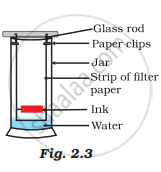Advertisements
Advertisements
Question
What will be the molality of the solution containing 18.25 g of \[\ce{HCl}\] gas in 500 g of water?
Options
0.1 m
1 M
0.5 m
1 m
Solution
1 m
Explanation:
The number of moles is given by the following formula,
Moles = `"Mass"/"Molar mass"` ......(1)
The number of moles of \[\ce{HCl}\] is calculated by using equation (1) as follows,
Moles of HCl = `(18.25 g)/((36.5 g)/(mol)` = 0.5 mol
The morality (m) is given by the formula:
m = `"n"/"mass of solvent"_((kg))`
On substituting the values in the above equation:
Molality = `(0.5 mol xx 1000 kg)/500` = 1 m
APPEARS IN
RELATED QUESTIONS
What is the concentration of sugar (C12H22O11) in mol L–1 if its 20 g are dissolved in enough water to make a final volume up to 2 L?
Solve the following problem:
Write the following number in ordinary decimal form:
5.16 × 104
Solve the following problem:
Write the following number in ordinary decimal form:
43.71 × 10−4
Solve the following problem:
Write the following number in ordinary decimal form:
14.3 × 10−2
Solve the following problem:
Perform the following calculation. Round off your answer to two digits.
`(1.4xx10^9)/((2.77xx10^3)(3.76xx10^5))`
Solve the following problem:
Perform the following calculation. Round off your answer to three digits.
(8.39 × 107) × (4.53 × 109)
Solve the following problem:
Perform the following calculation. Round off your answer to three digits.
`(8.94xx10^6)/(4.35xx10^4)`
A child wanted to separate the mixture of dyes constituting a sample of ink. He marked a line by the ink on the filter paper and placed the filter paper in a glass containing water as shown in Fig.2.3. The filter paper was removed when the water moved near the top of the filter paper.
(i) What would you expect to see, if the ink contains three different coloured components?
(ii) Name the technique used by the child.
(iii) Suggest one more application of this technique.

What will be the molarity of a solution, which contains 5.85 g of NaCl(s) per 500 mL?
